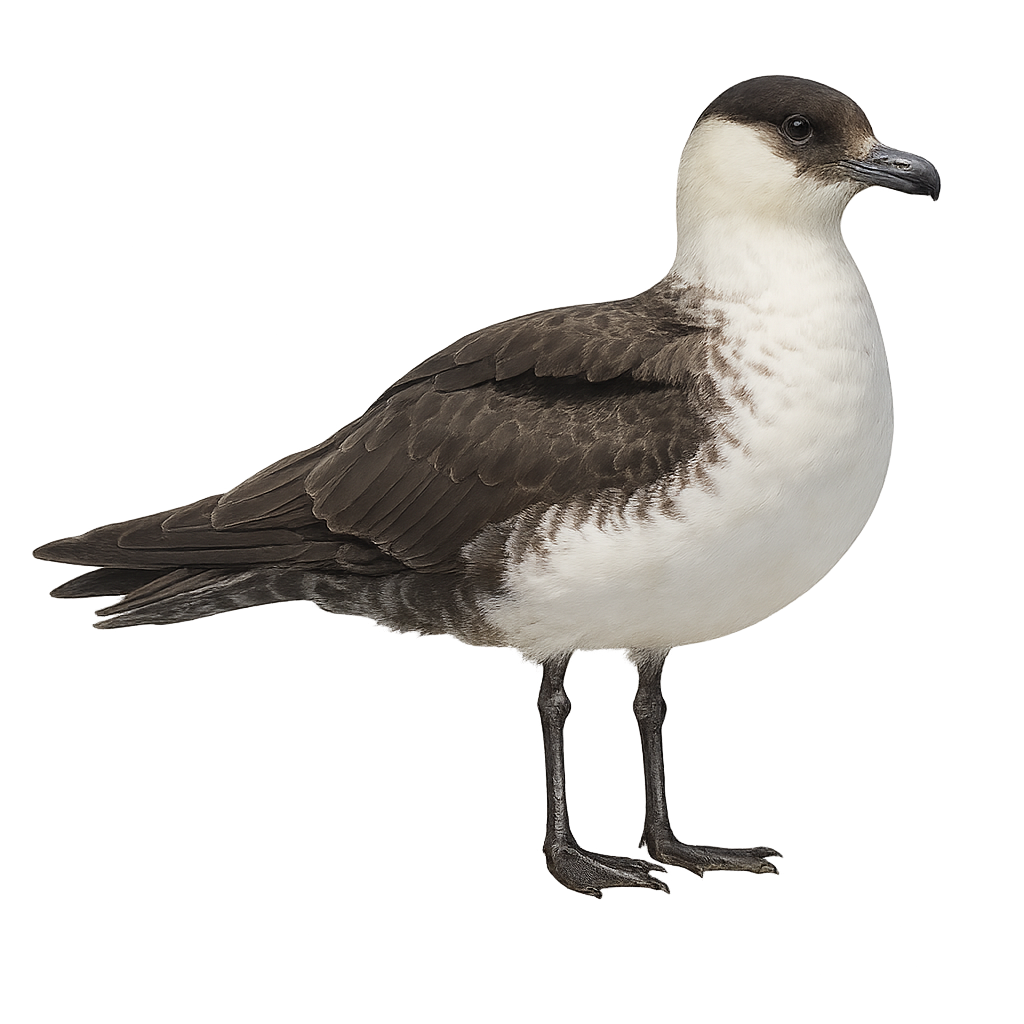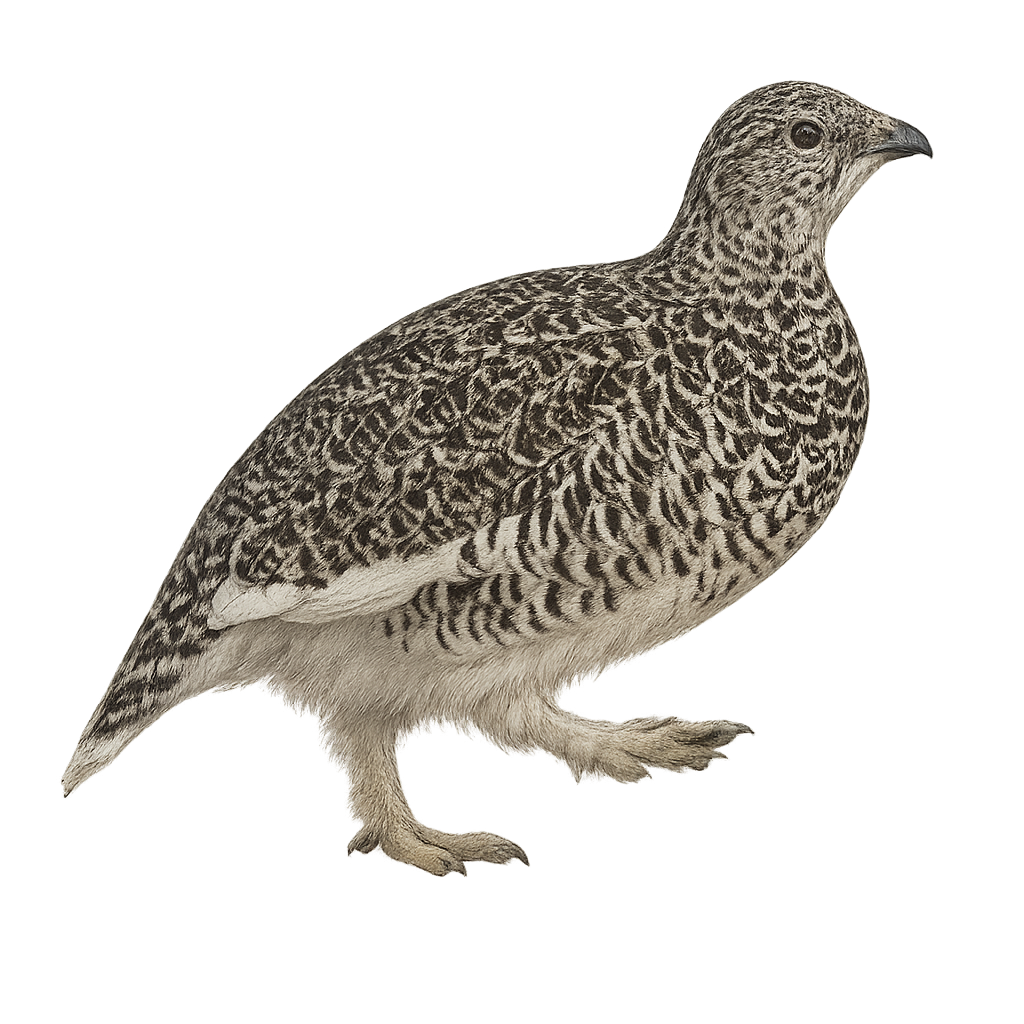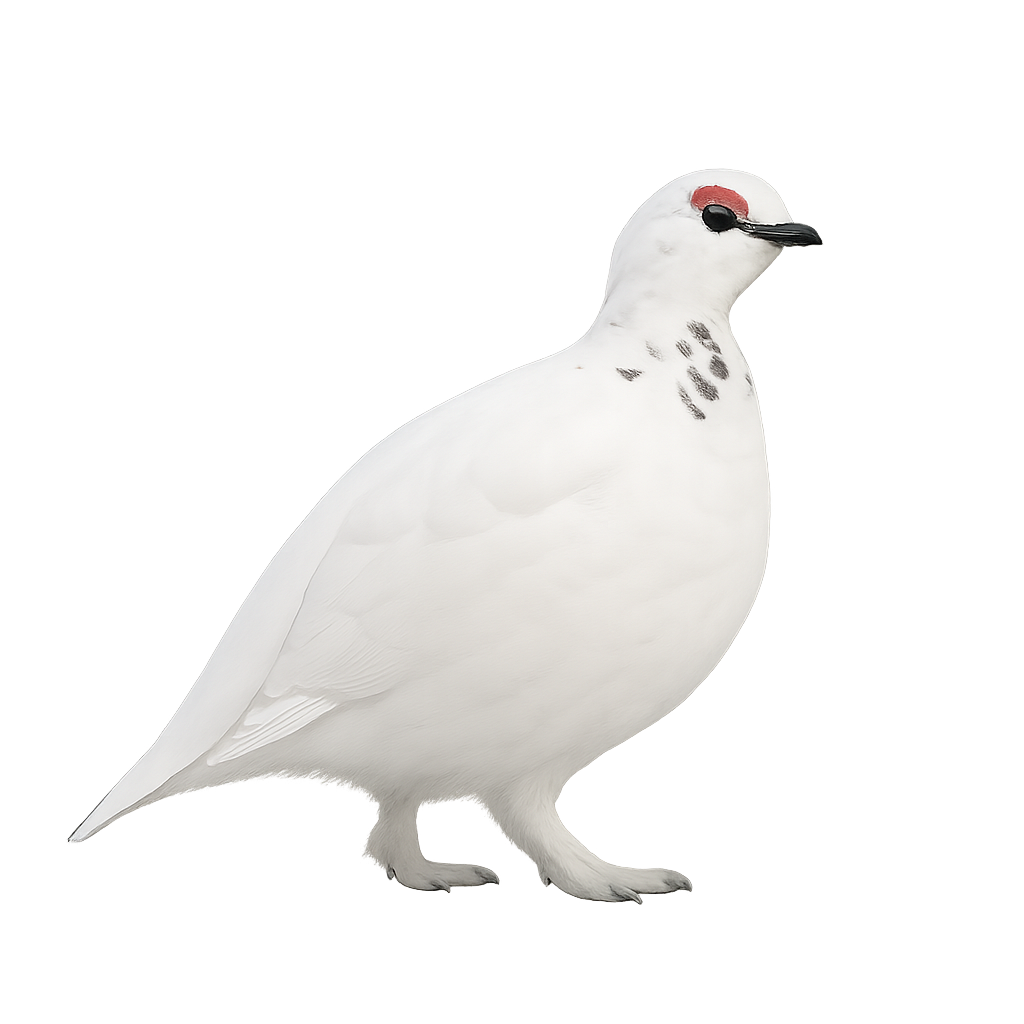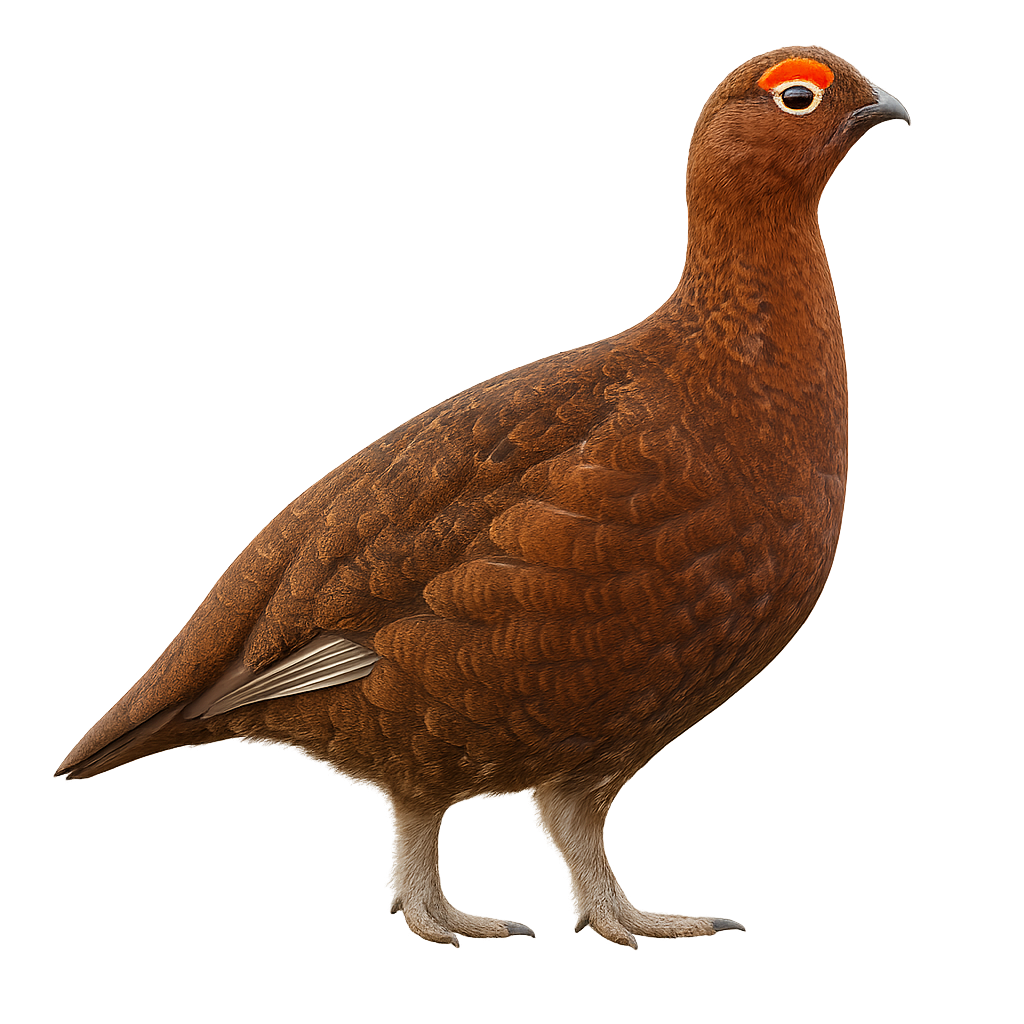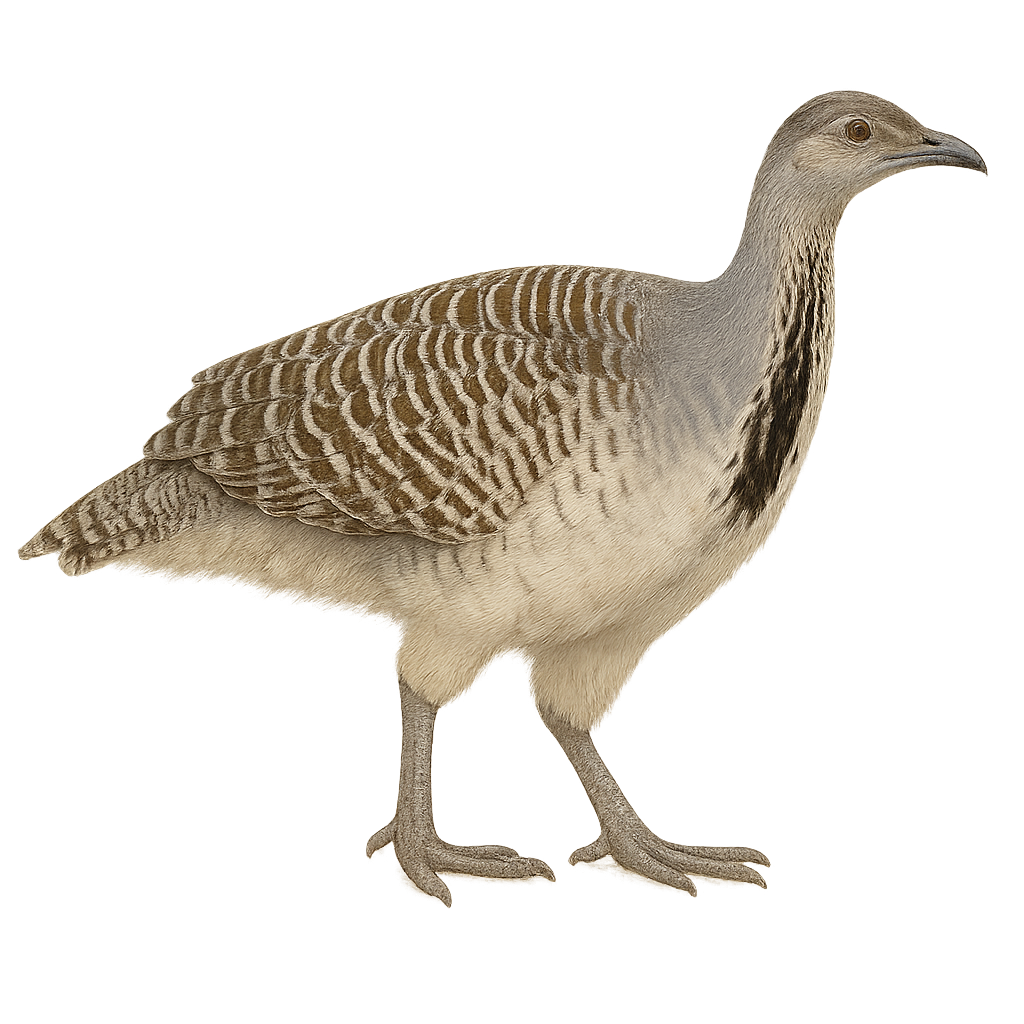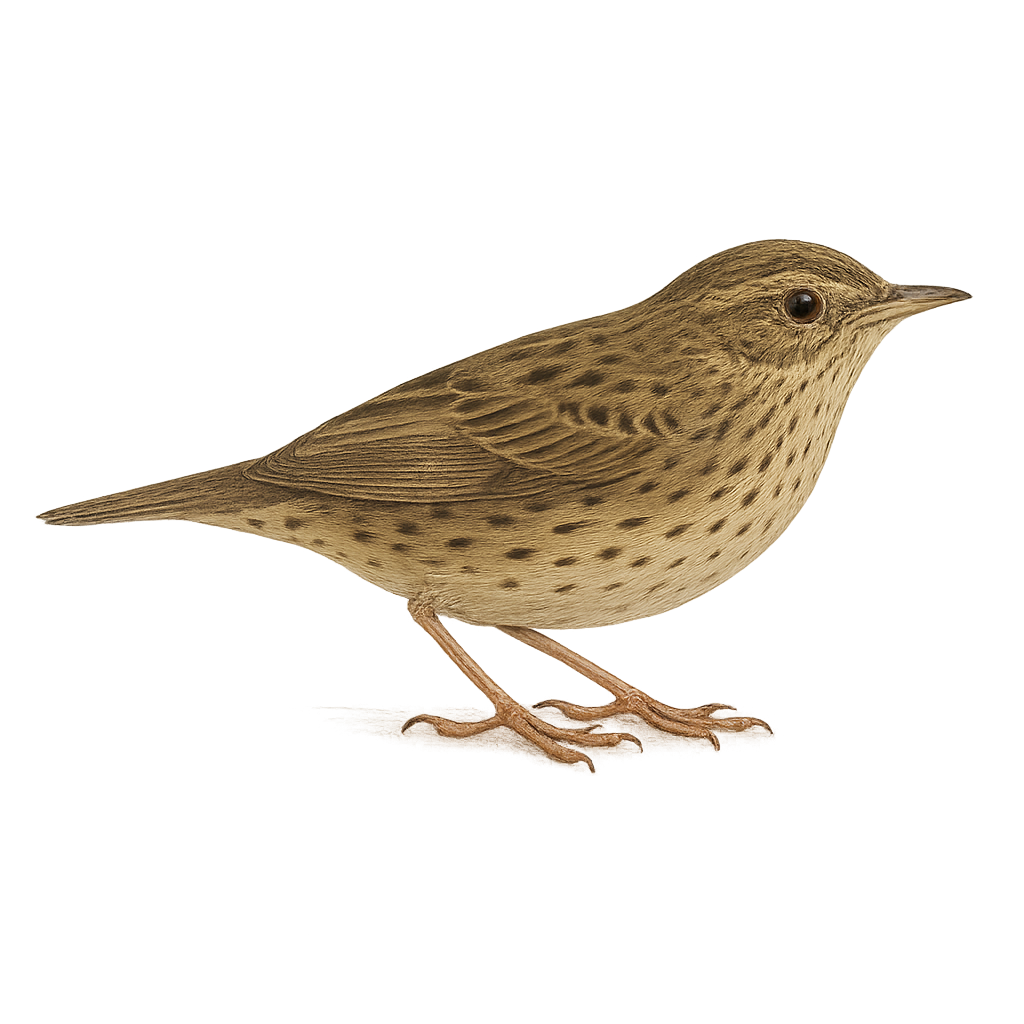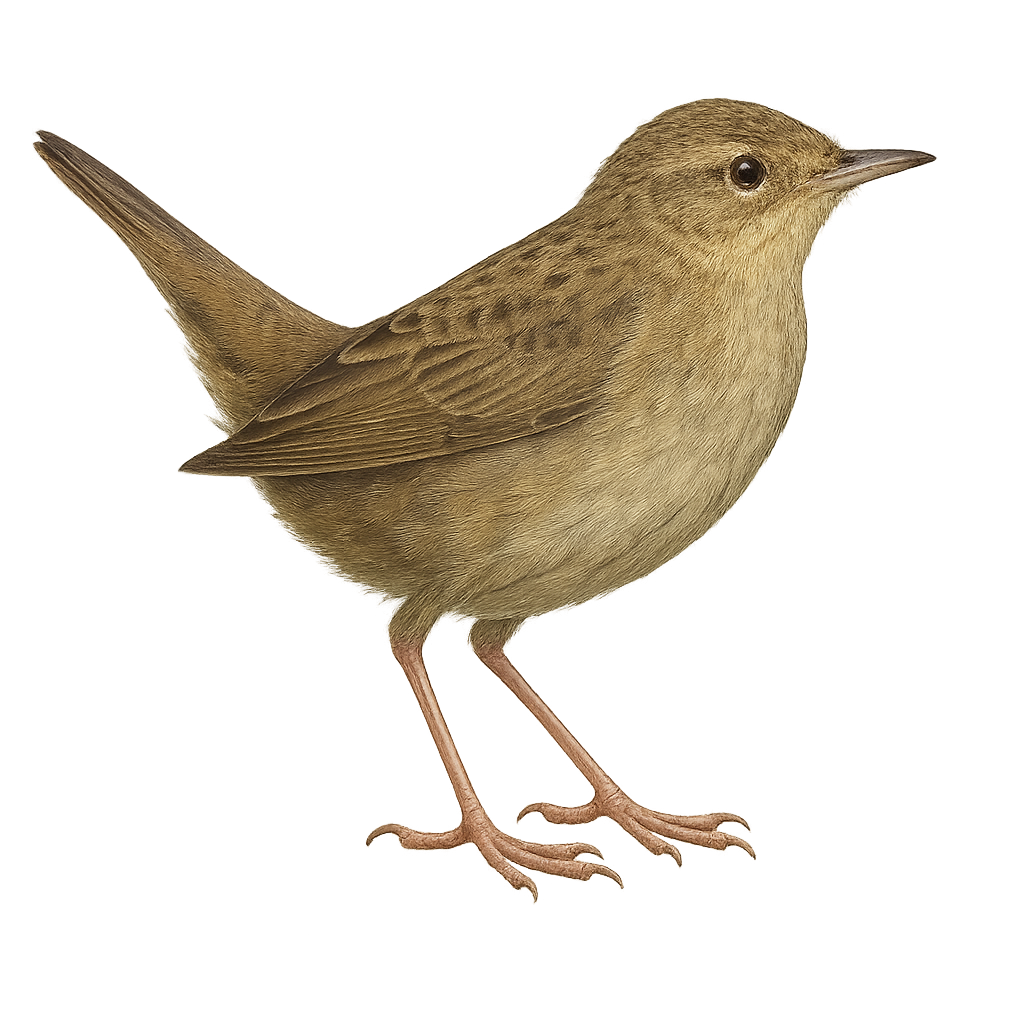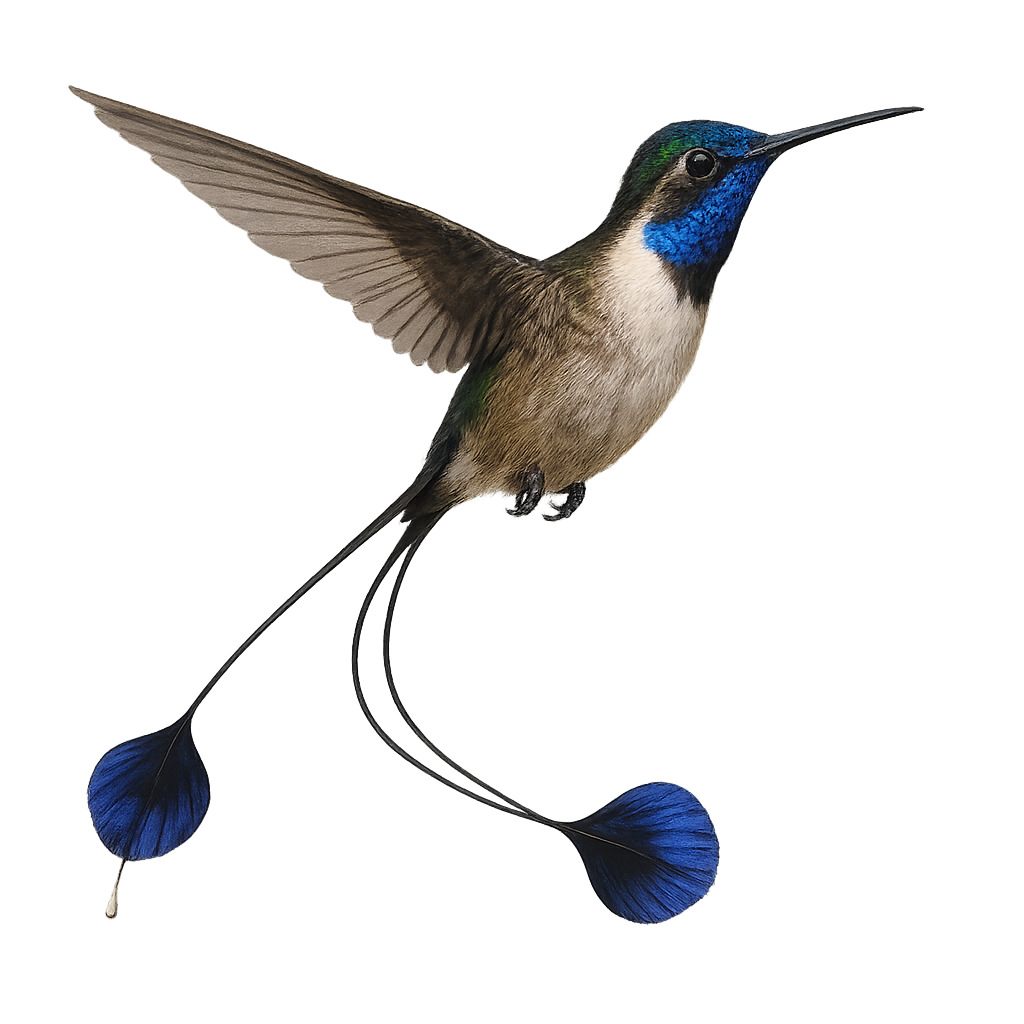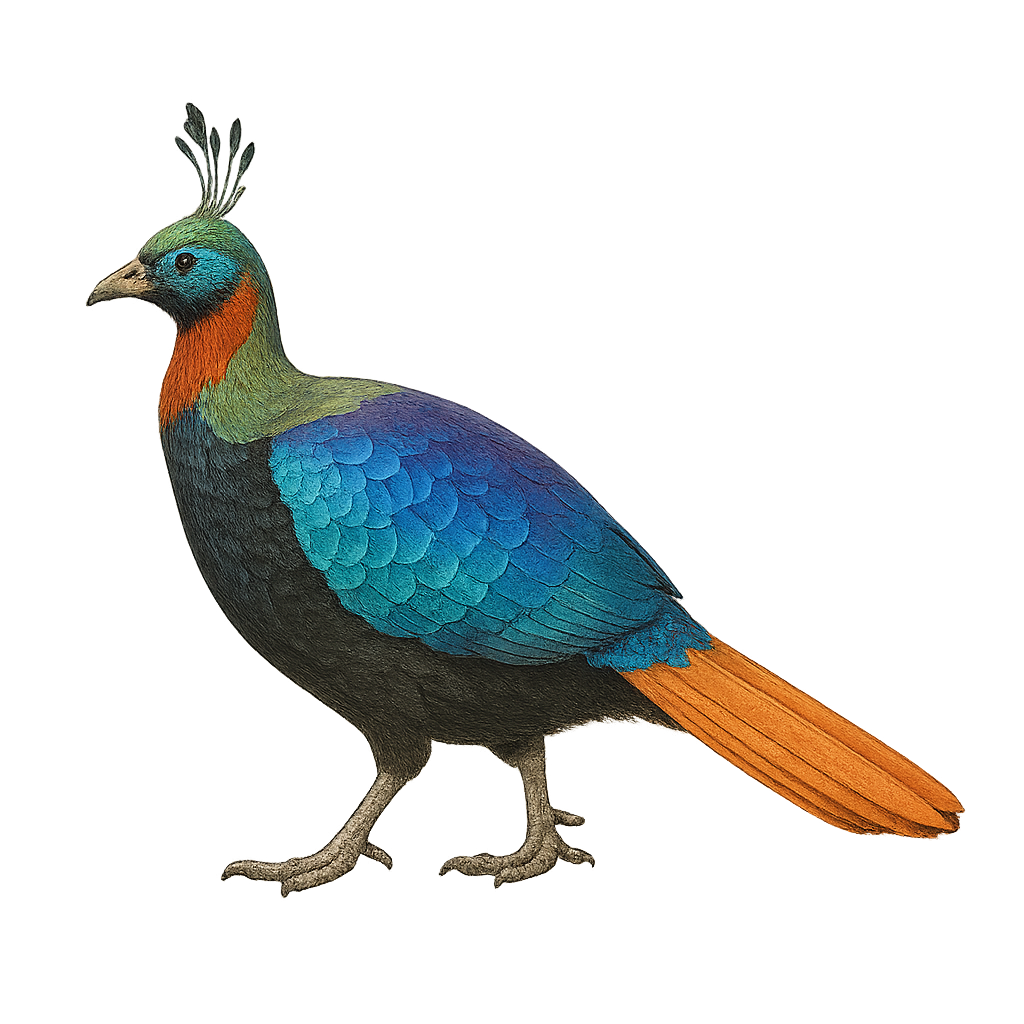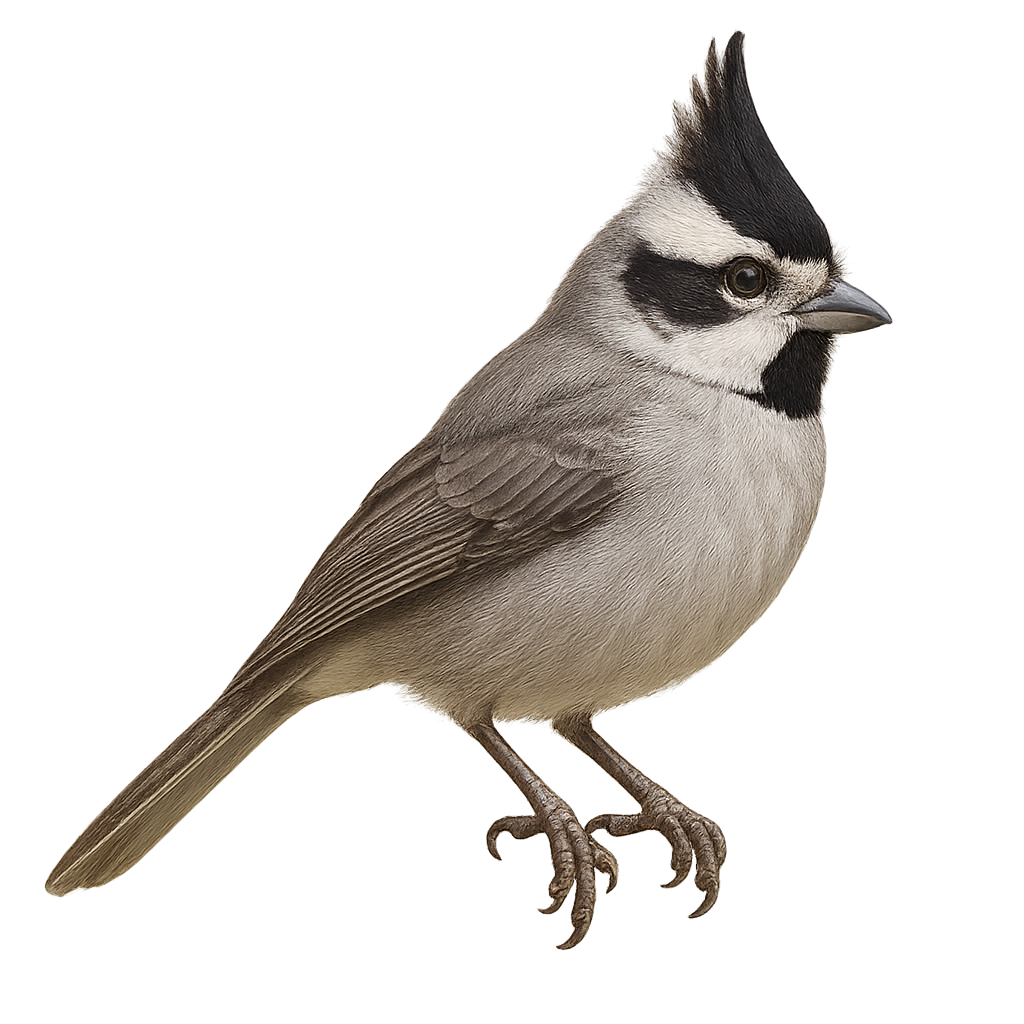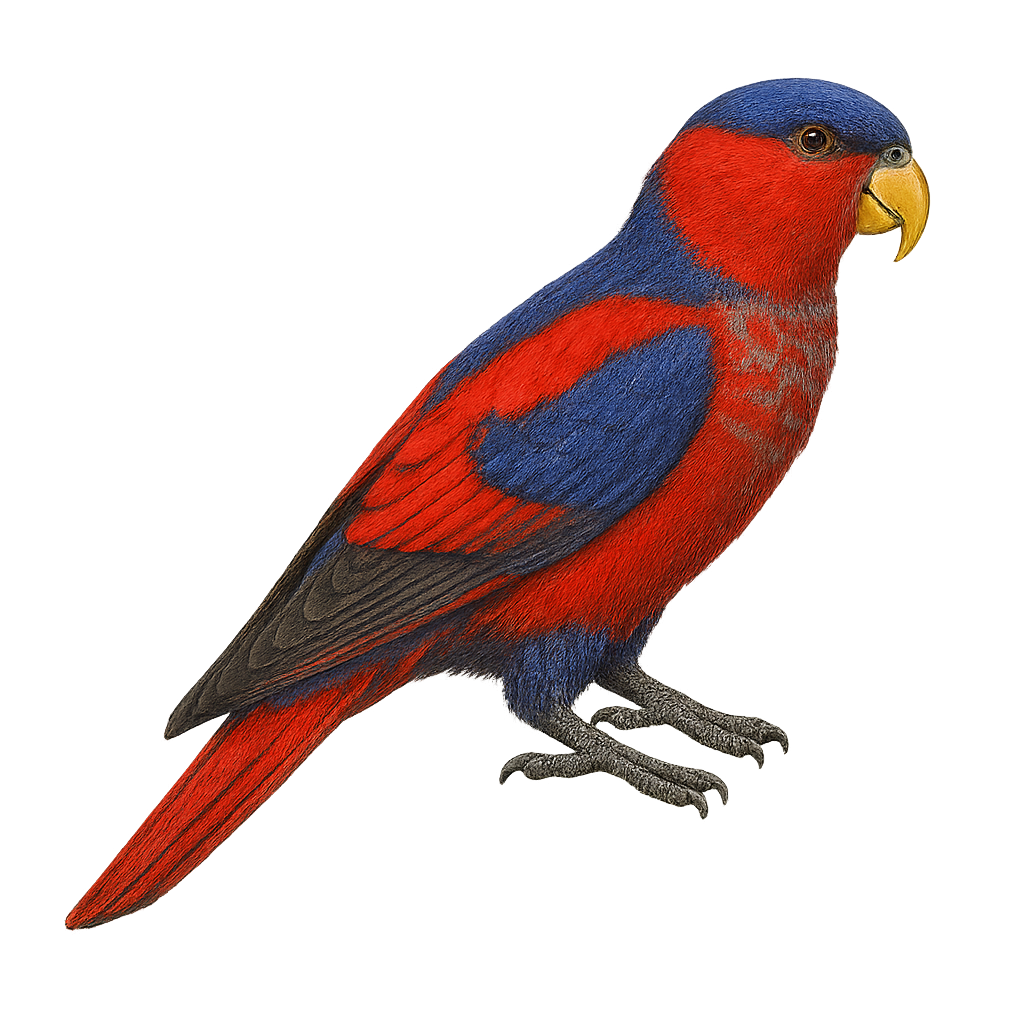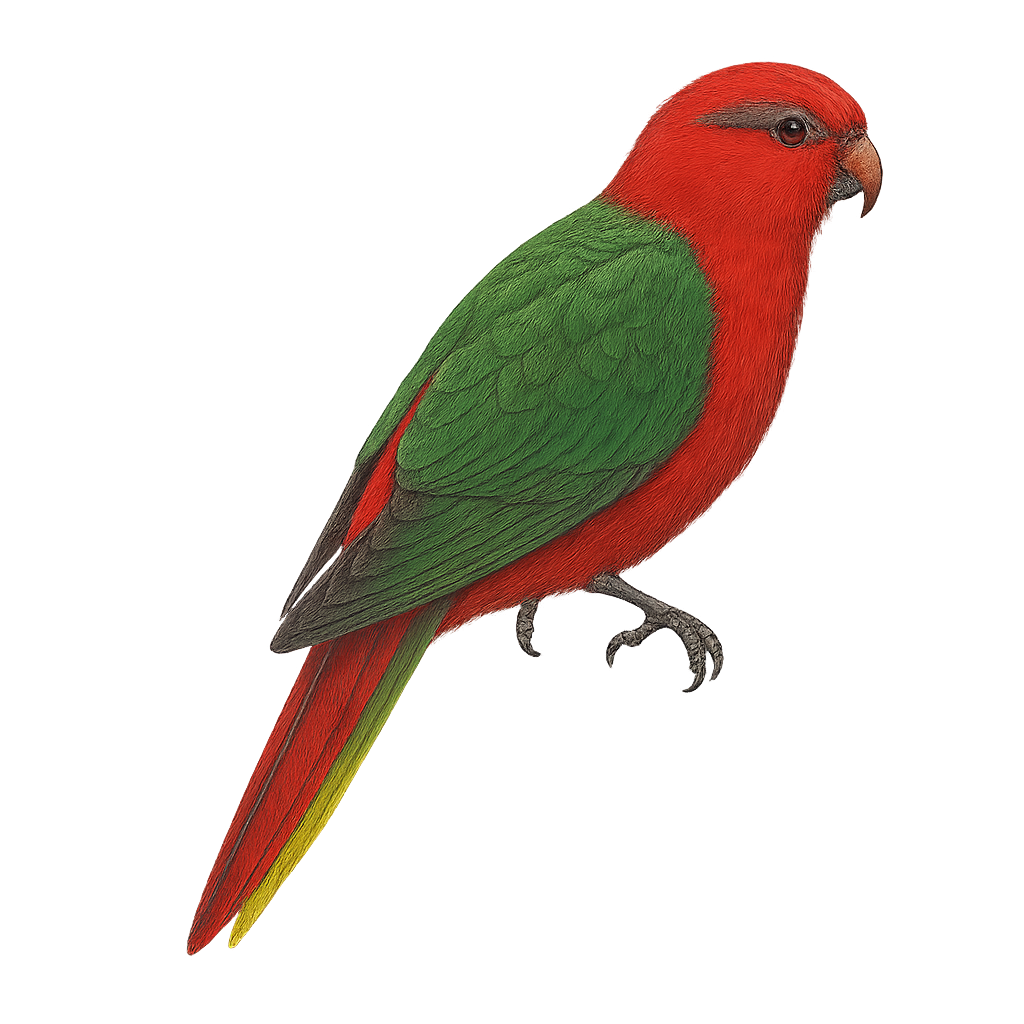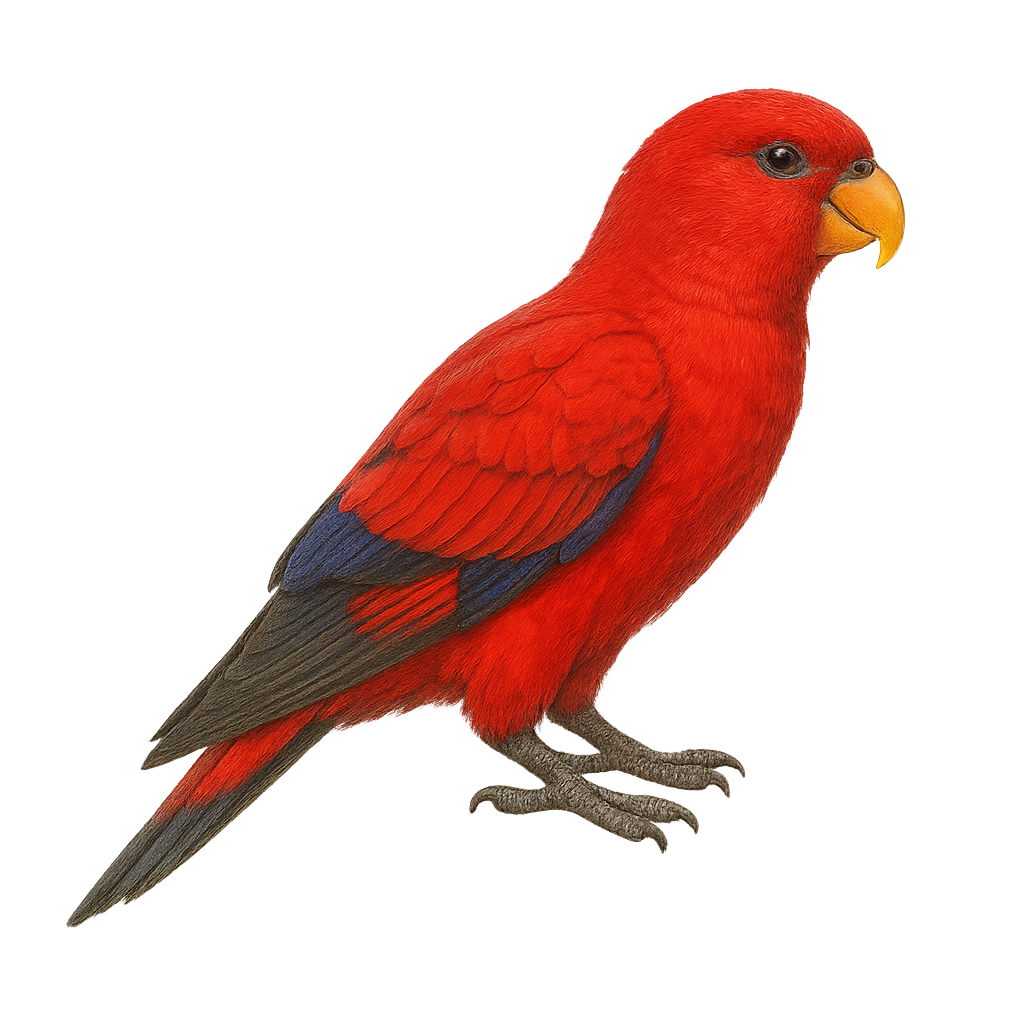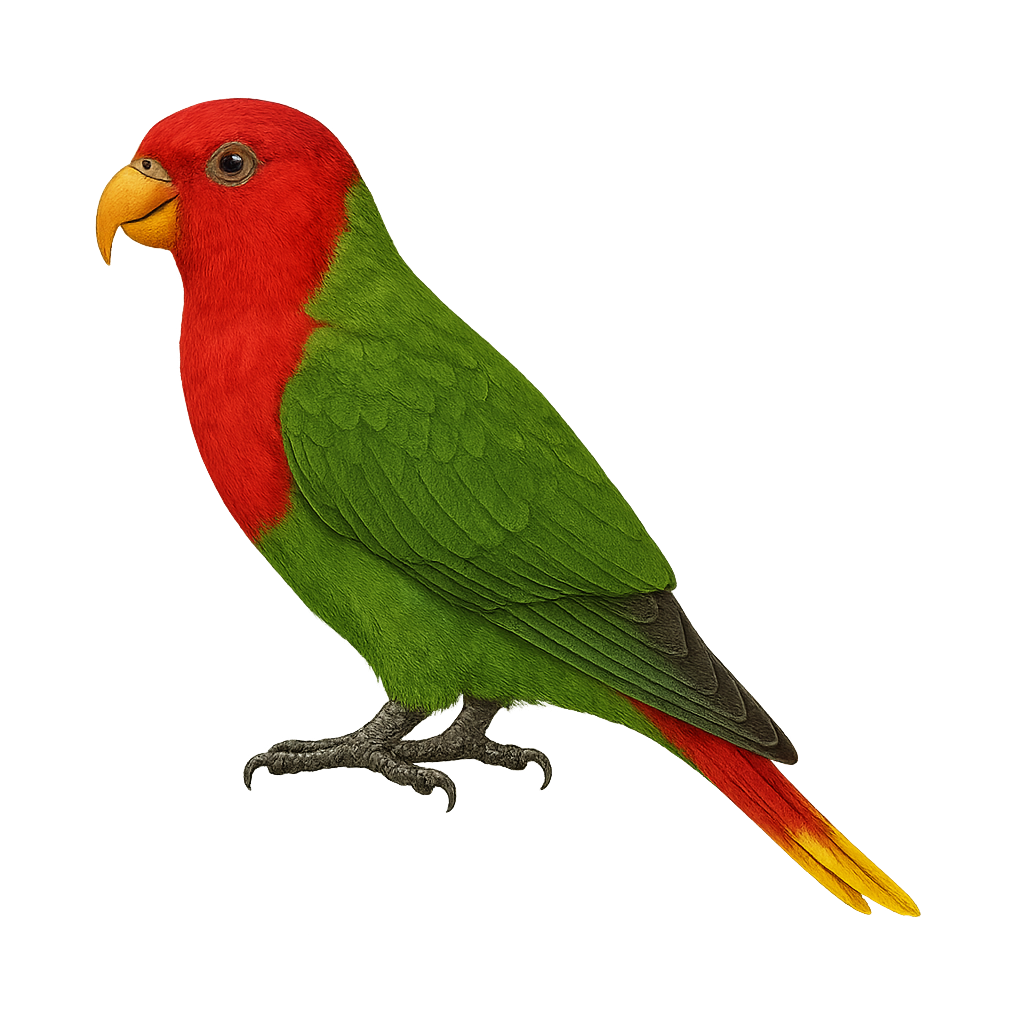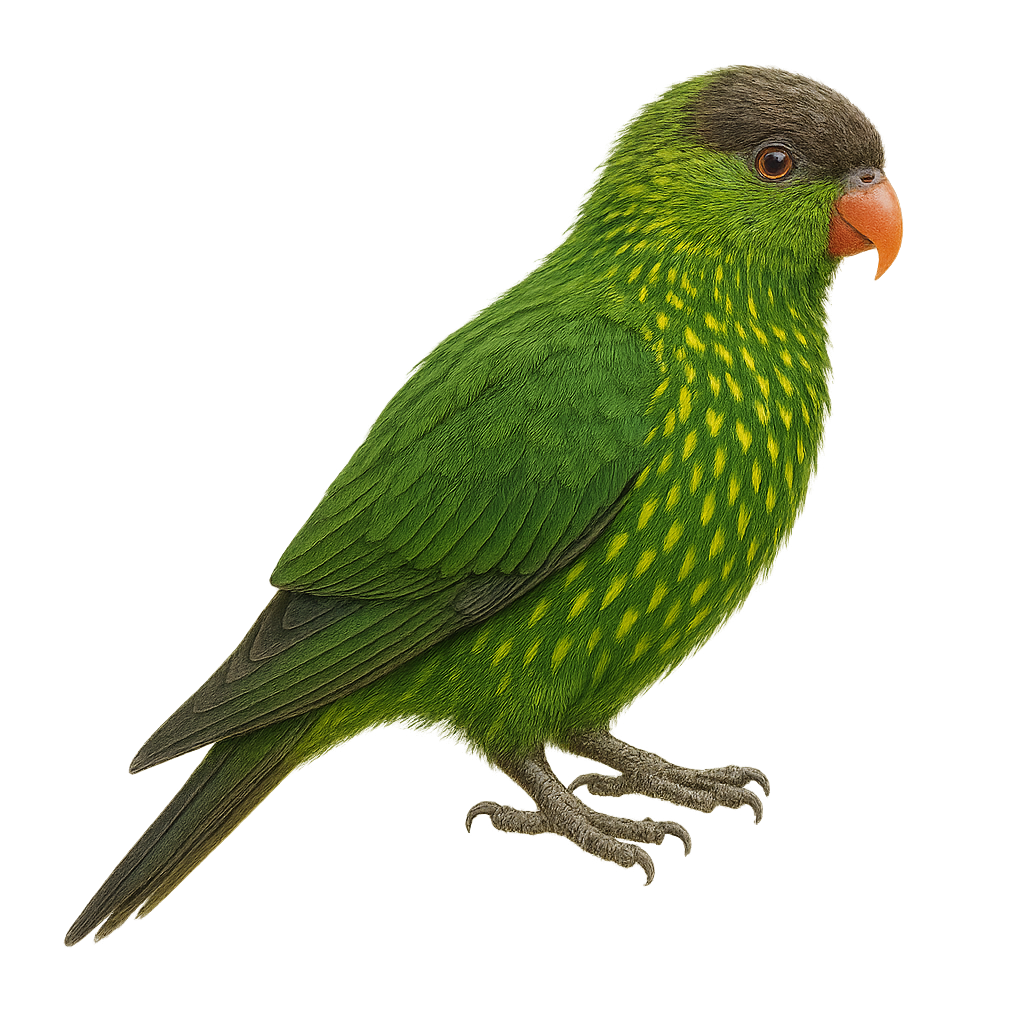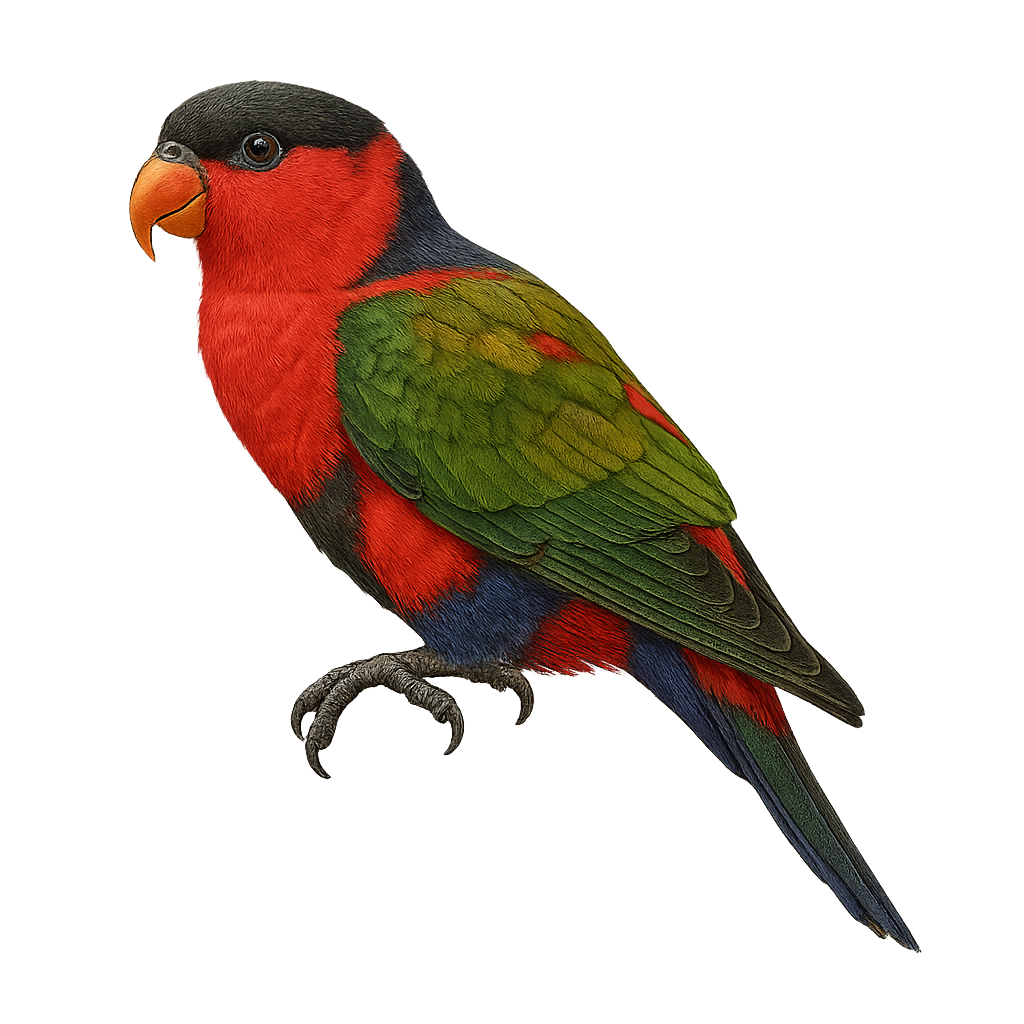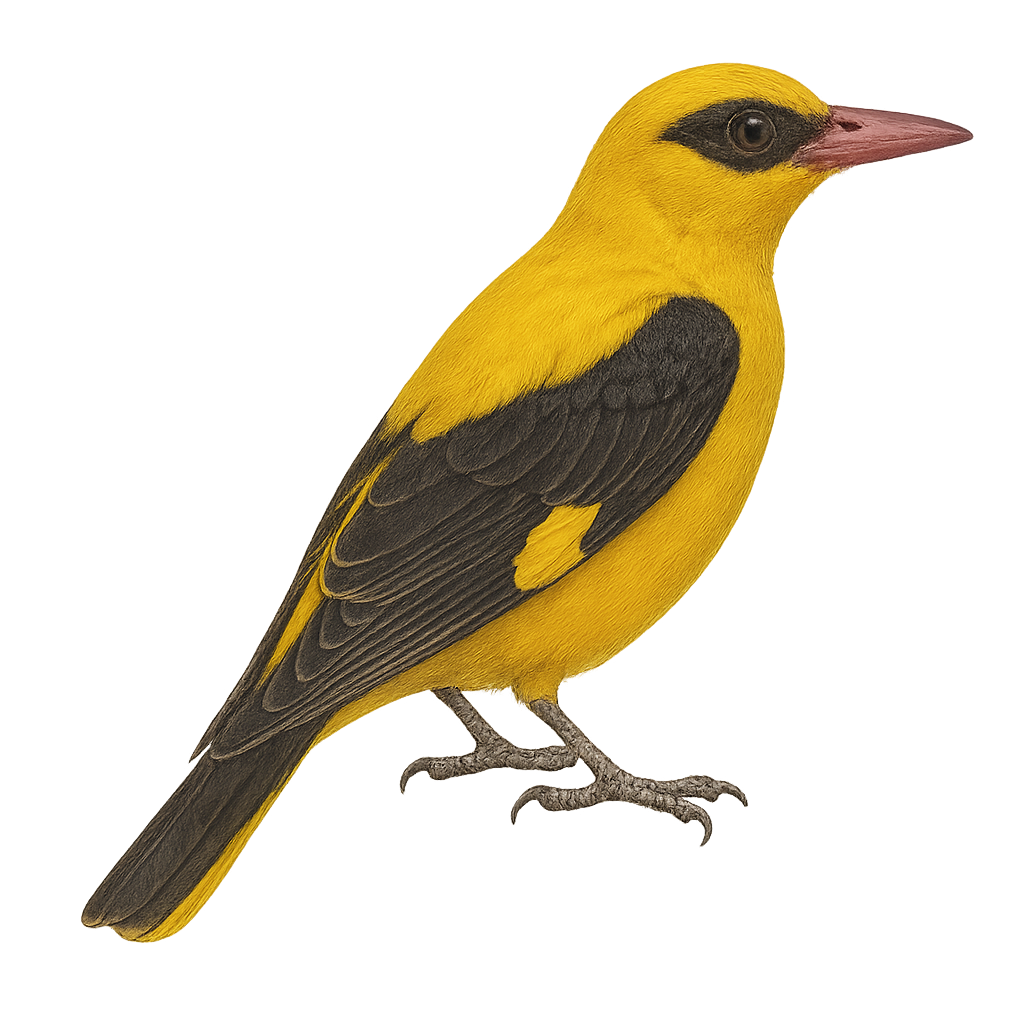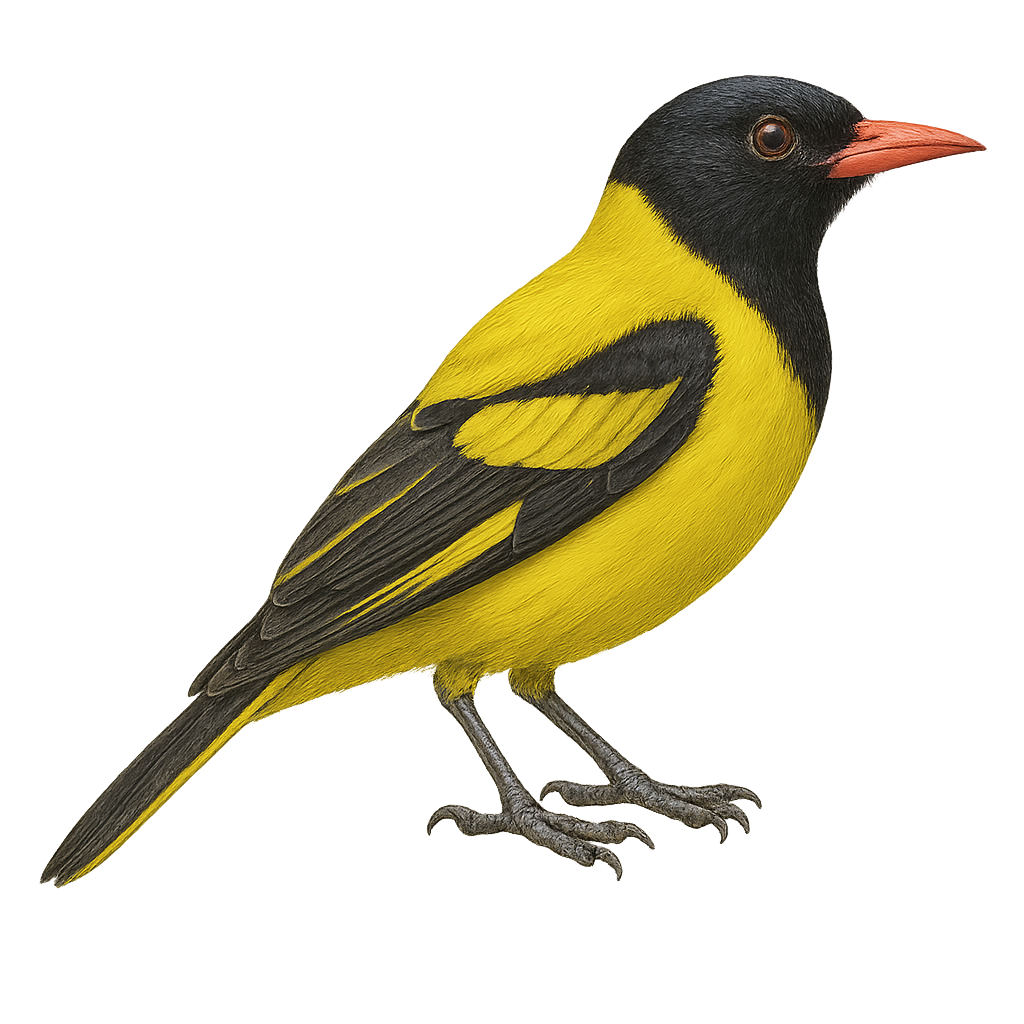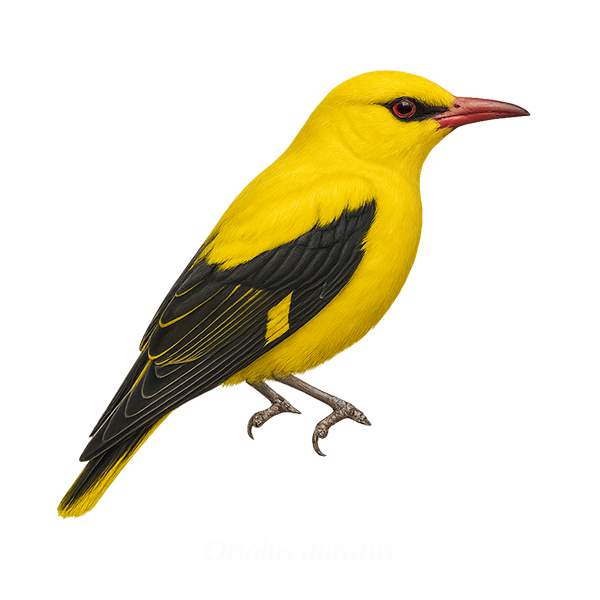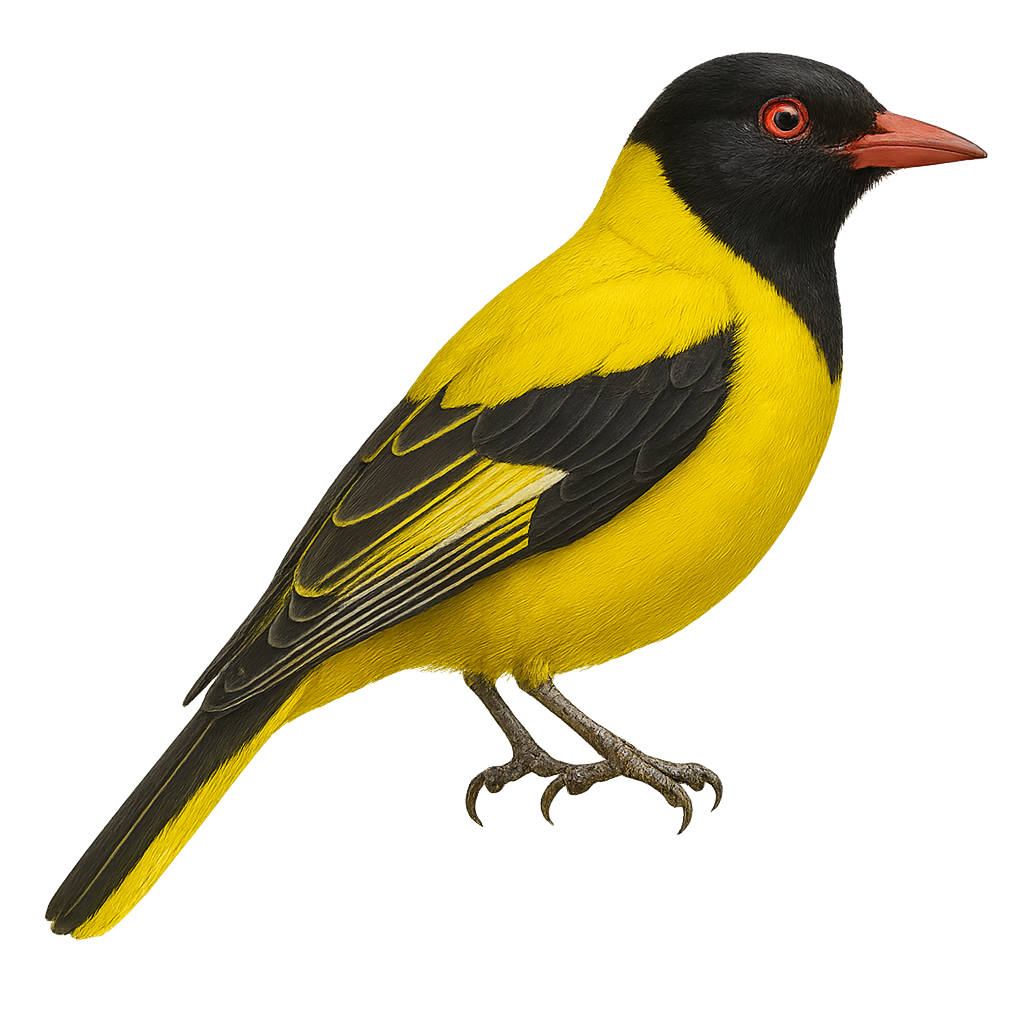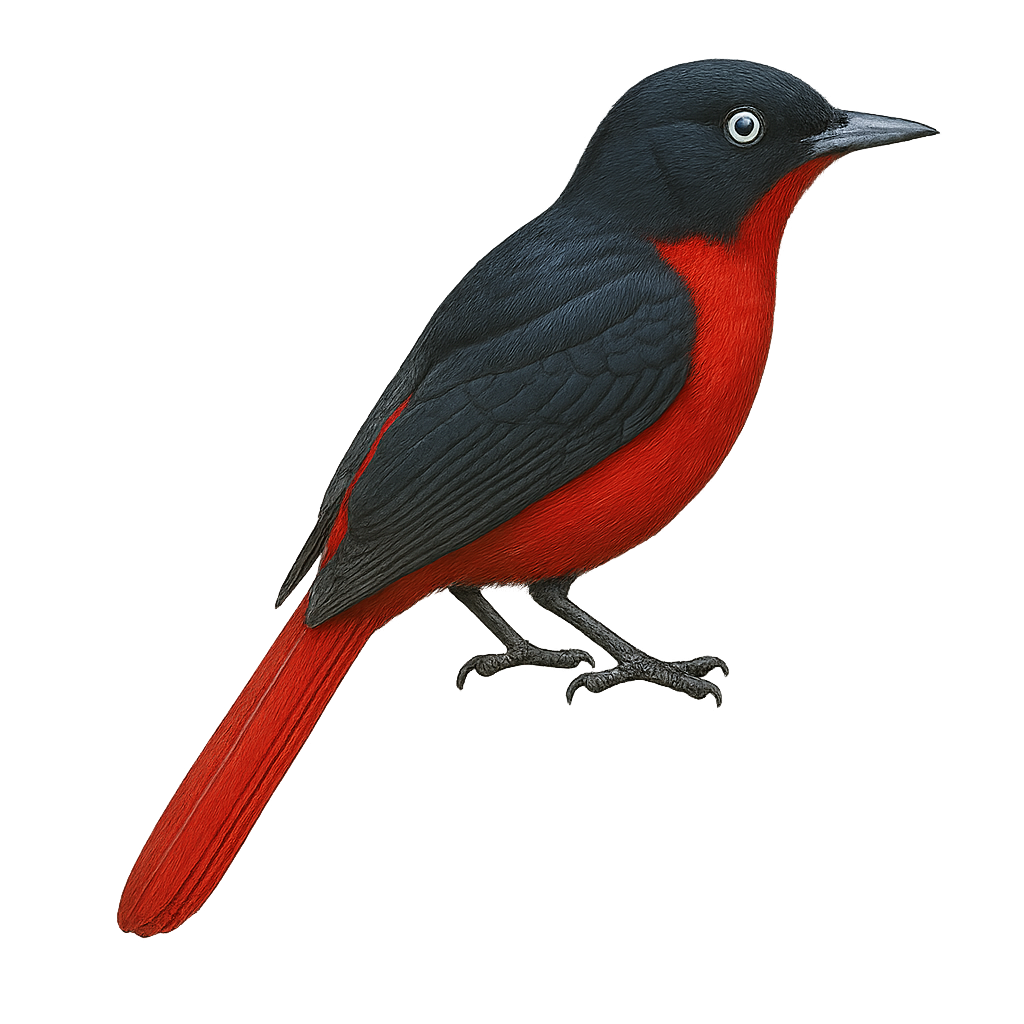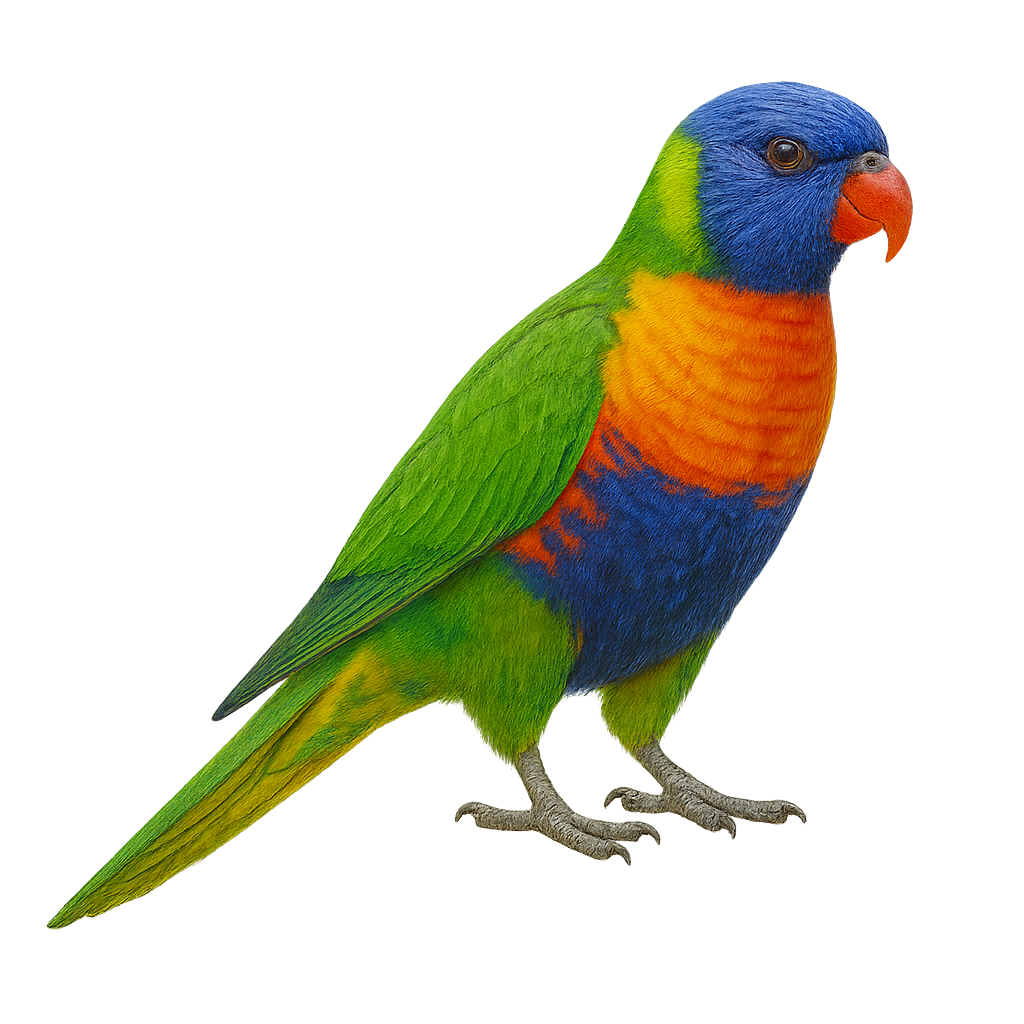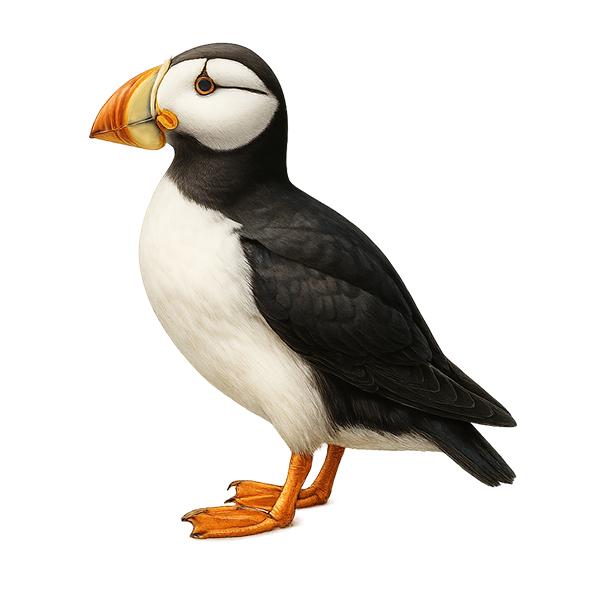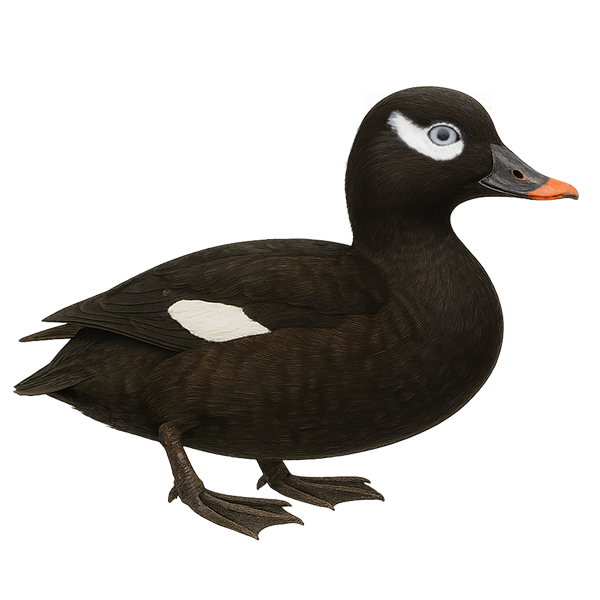The Parasitic Jaeger, or Stercorarius parasiticus, is a medium-sized seabird, easily recognizable by its pointed wings and dark plumage. It measures about 45 to 50 cm in length, with a wingspan of 110 to 125 cm, and weighs between 300 and 450 g. Its plumage is typically dark brown or gray on the back, with a lighter belly. Adults have a distinctive feature: a forked tail with extended feathers, especially in males. The Parasitic Jaeger is a migratory bird that primarily inhabits the Arctic and subarctic regions but moves to more temperate zones during the winter. This bird is particularly known for its parasitic behavior, in which it chases other seabirds to force them to drop their catch, allowing the Jaeger to steal their food. The Parasitic Jaeger is also an excellent flyer, capable of traveling long distances. While the species is not endangered, it is sensitive to human disturbances and climate changes that affect its coastal habitat.
The Pomarine Jaeger is a medium-sized seabird known for its long, pointed wings and spatula-shaped tail. It has a dark brown plumage with lighter underparts and distinctive white wing markings. This agile predator is often seen chasing other birds to steal their food. It breeds mainly in Arctic regions and migrates to southern oceans in winter. Its preferred habitat includes coastal areas and open seas. The Pomarine Jaeger is an opportunistic bird, capable of adapting to various marine environments to survive.
The White-tailed Ptarmigan is a bird from the grouse family, well adapted to alpine environments. It is notable for its white plumage in winter, which provides camouflage in the snow, and brown plumage in summer, blending with rocks and vegetation. This small bird, weighing about 300 to 400 grams, is primarily herbivorous, feeding on buds, leaves, and seeds. It is commonly found in the mountainous regions of North America, particularly in the Rockies. The White-tailed Ptarmigan is a sedentary bird, not migrating but moving according to climatic conditions and food availability.
The Rock Ptarmigan is a mountain bird adapted to the harsh conditions of high peaks. It measures about 35 to 40 cm in length and weighs between 350 and 650 g. In winter, its plumage is entirely white, allowing it to blend into the snow, while in summer, it has a brown-red plumage with dark spots to better blend into the rocks and grasses of the mountains. The Rock Ptarmigan primarily inhabits mountainous regions of Europe, Asia, and North America at high altitudes, where it feeds on plants, seeds, berries, and young shoots. Due to its thick plumage and feather-covered legs, it is well adapted to cold conditions but is also vulnerable to climate change, particularly to the loss of its mountainous habitat. The species is protected in some areas but remains sensitive to human disturbances, such as mountain tourism and temperature changes.
The Scottish Ptarmigan, or Lagopus lagopus scotica, is a subspecies of the Willow Ptarmigan, specifically found in the mountains of Scotland. It measures about 30 to 35 cm in length and weighs between 300 and 450 g. Its plumage changes with the seasons: in winter, it is entirely white, allowing it to blend perfectly into the snow, while in summer, it has a brown-red spotted plumage that makes it blend into the Scottish moorlands. The Scottish Ptarmigan inhabits the highlands, particularly in the northern mountains of Scotland, where it primarily feeds on plants, berries, seeds, and young shoots. Although it is a bird difficult to spot due to its excellent camouflage, it remains vulnerable to climate change and the loss of its natural habitat. The Scottish Ptarmigan is also threatened by predation from foxes and mustelids and by human activities, including tourism and land management.
The Willow Ptarmigan is a mountain bird, smaller than its cousin the Rock Ptarmigan, found in cold regions and forested areas of northern Europe and Asia. It measures about 30 to 35 cm in length and weighs between 250 and 400 g. Its plumage changes with the seasons: in winter, it is entirely white, allowing it to blend into the snow, while in summer, it has a brown-red spotted plumage, perfect for blending into the moors and shrubs. The Willow Ptarmigan primarily inhabits taiga and tundra regions, where it feeds on leaves, berries, and young shoots. It is often seen on the ground or in bushes, searching for food. While the species is not immediately threatened, it is vulnerable to disturbances from deforestation and climate change, which affect mountain ecosystems.
The Leipoa ocellata, or Malleefowl, is a unique terrestrial bird endemic to the arid and semi-arid regions of Australia. This medium-sized bird, measuring about 60 cm in length, is easily recognizable by its brown plumage speckled with white and black, allowing it to blend into its surroundings. It is famous for its unusual breeding method: the male builds a large mound of earth and vegetation, where the female lays her eggs. The heat generated by the decomposition of organic matter incubates the eggs. The Malleefowl is a discreet bird, often difficult to observe, as it prefers to move on foot and quickly hides when threatened.
The Lanceolated Warbler is a small, elusive bird belonging to the Locustellidae family. It is characterized by its brownish plumage, finely streaked with black, which allows it to blend into its natural habitat. This bird prefers wetlands, meadows, and marshes, where it primarily feeds on insects and small invertebrates. Its song is a rapid, monotonous trill, often heard at dusk. The Lanceolated Warbler is migratory, spending its summers in Eurasia and winters in Southeast Asia. Although its conservation status is currently "least concern," it is threatened by habitat destruction due to intensive agriculture and wetland drainage.
The common grasshopper warbler is a small passerine about 13 cm long with streaked brown upperparts and long undertail coverts. Secretive in dense grassy vegetation and low scrub at water margins, it feeds on insects gleaned from foliage. During breeding, the male sings from a low branch or elevated grass stem to defend its territory and court the female.
The Marvelous Spatuletail, or Loddigesia mirabilis, is a fascinating and rare bird endemic to Peru. This hummingbird is famous for its spectacular tail feathers, which end in racket-shaped spatules. Males display vibrant plumage with bright colors, while females are more subdued. They primarily inhabit cloud forests and wooded areas at altitudes between 2100 and 2900 meters. Their diet mainly consists of nectar, which they extract while hovering, and insects. Their behavior is generally suspicious, making them a challenge for birdwatchers and photographers to observe.
The Himalayan Monal, or Lophophorus impejanus, is a striking bird native to the mountainous regions of the Himalayas. Known for its iridescent plumage, the male displays a dazzling array of metallic blues, greens, and purples, while the female is more subdued with mottled brown feathers for camouflage. These birds inhabit coniferous forests and alpine meadows, feeding on roots, tubers, and insects. Although capable of flight, they prefer to walk or run on the ground. Their call is a sharp, resonant cry that echoes through the mountain valleys.
The Grey-hooded Sierra Finch, or Lophospingus pusillus, is a small passerine bird belonging to the Thraupidae family. It is primarily found in the arid and semi-arid regions of South America, particularly in Argentina, Bolivia, and Paraguay. This bird is distinguished by its characteristic grey crest and brownish plumage. It measures about 14 cm in length and feeds mainly on seeds and insects. The Grey-hooded Sierra Finch is often seen in small groups, moving around in search of food. Although relatively discreet, its melodious song can be heard from a distance. The species is currently classified as of least concern by the IUCN but remains sensitive to environmental changes.
The Red-and-blue Lory, or Mesitornis variegatus, is a vibrant and fascinating bird endemic to the Talaud and Sangihe Islands in Indonesia. This parrot boasts a striking plumage, predominantly red with shades of blue on its wings and tail. Its beak is a vivid orange, contrasting with its dark, expressive eyes. Measuring about 30 cm in length, it is known for its liveliness and intelligence. The Red-and-blue Lory primarily inhabits tropical rainforests, where it feeds on nectar, fruits, and flowers. Unfortunately, this species is critically endangered, mainly due to habitat loss and illegal trade in exotic birds.
The Josephine's Lorikeet, or Charmosyna josefinae, is a small, colorful parrot native to the tropical forests of New Guinea. It is distinguished by its vibrant plumage, primarily green with touches of red and blue. This lorikeet is particularly adapted to arboreal life, feeding mainly on nectar and pollen, but also on fruits and insects. Its curved beak is ideal for accessing flowers, and its social behavior often makes it visible in small groups. Although its habitat is threatened by deforestation, it remains relatively common in protected areas. Its ability to fly quickly and its distinctive call make it a fascinating bird to observe.
The Red Lory, or Trichoglossus borneus, is a vibrant parrot native to the Moluccas in Indonesia. This lory is known for its striking red plumage, highlighted with blue and black on its wings and tail. Measuring about 30 cm in length, it has a strong, curved beak, perfect for feeding on nectar, fruits, and flowers. Sociable and noisy, it lives in groups and frequents tropical rainforests, mangroves, and plantations. Its flight is fast and direct, often accompanied by loud calls. Although popular in the pet trade, its wild population is threatened by deforestation and trapping.
The Papuan Lorikeet, Charmosyna pulchella, is a small, colorful parrot native to New Guinea. This stunning bird features a vibrant plumage with shades of green, red, and blue, making it easily recognizable. It measures about 18 cm in length and is characterized by its tapered tail and pointed wings. The Papuan Lorikeet is a sociable bird, often seen in small groups, feeding primarily on nectar, pollen, and fruits. It inhabits tropical rainforests, forest edges, and occasionally gardens. Although relatively common in its natural habitat, preserving its environment is crucial for its long-term survival.
The Striated Lorikeet, Charmosyna multistriata, is a small, colorful parrot native to the tropical forests of New Guinea. This lorikeet is distinguished by its bright green plumage adorned with fine red and yellow stripes on its belly, and a vivid orange beak. It measures about 18 cm in length and weighs between 30 and 40 grams. Its natural habitat includes lowland and mid-altitude rainforests, where it primarily feeds on nectar, pollen, and fruits. Although its conservation status is concerning due to deforestation, it remains relatively common in some areas. The Striated Lorikeet is known for its sociability and tendency to move in small, noisy groups.
The Rainbow Lorikeet, or Lorius lory, is a colorful parrot native to the tropical forests of New Guinea and surrounding islands. This stunning bird is distinguished by its vibrant plumage, blending shades of red, blue, green, and yellow. It measures about 25 to 30 cm in length and weighs between 130 and 200 grams. The Rainbow Lorikeet is known for its curved beak and brush-tipped tongue, adapted to its diet mainly consisting of nectar and fruits. Sociable and noisy, it often lives in groups and is renowned for its aerial acrobatics. Its ability to mimic sounds also makes it a popular bird in captivity.
The European Golden Oriole is a brightly colored bird, easily recognizable by its striking plumage. The male is particularly vivid yellow with black wings, while the female has a more subdued plumage, mainly olive green and yellow. It measures about 25 cm in length and weighs between 40 and 60 g. This migratory passerine bird primarily inhabits open forests, orchards, and hedgerows, mostly in Europe, and migrates to North Africa for the winter. The European Golden Oriole is known for its melodious and powerful song, consisting of clear and repetitive notes. Its diet is primarily insectivorous, feeding on caterpillars, wasps, and other insects, but it also consumes fruits such as berries. This bird is discreet and hard to observe as it spends most of its time high up in trees. While its population is stable in some regions, it is threatened by deforestation, the loss of its natural habitat, and the reduction of its food sources due to pesticide use.
The Black-naped Oriole, or Oriolus chinensis, is a striking bird with bright yellow plumage, primarily yellow with black wings and tail. It is distinguished by a black patch on the nape, hence its English name. This bird is often seen in the tropical and subtropical forests of Asia, where it feeds mainly on fruits, insects, and small invertebrates. Its melodious and fluid song is a delight for birdwatchers. The Black-naped Oriole is a partial migratory bird, moving according to the seasons to find food resources. Although generally solitary, it can be observed in small groups during migration.
The Percival's Oriole is a fascinating bird primarily inhabiting the tropical and subtropical forests of East Africa. Recognizable by its striking plumage, it features a vibrant mix of colors, including shades of yellow, black, and sometimes green. This oriole is a medium-sized bird, measuring about 20 to 25 cm in length. It is known for its melodious and complex song, often heard at dawn. The Percival's Oriole is a sociable bird, often seen in small groups or pairs. It mainly feeds on insects, fruits, and nectar, playing a crucial role in the pollination of many plants. Although relatively common in its natural habitat, deforestation and habitat loss pose potential threats to its population.
The African Golden Oriole, or Oriolus auratus, is a medium-sized bird known for its striking plumage and melodious songs. It features bright yellow plumage with black wings, making it easily recognizable. This bird is primarily found in sub-Saharan Africa, where it inhabits open forests, wooded savannas, and bushy areas. The African Golden Oriole is a partial migrant, moving seasonally to find food resources. It feeds mainly on insects, fruits, and nectar. Its song is a soft whistle, often heard during the breeding season. Although its habitat is threatened by deforestation, it is currently listed as "Least Concern" by the IUCN.
The African Golden Oriole, scientifically known as Oriolus larvatus, is an elegant and colorful bird found primarily in sub-Saharan Africa. It is easily recognizable by its bright yellow plumage contrasted with a distinctive black head. This bird prefers wooded habitats and open forests, where it primarily feeds on fruits, insects, and nectar. The African Golden Oriole is a diurnal bird, most active in the morning and late afternoon. It is often seen alone or in small groups, and its melodious song is an indicator of its presence. Although generally discreet, it can be observed moving between trees in search of food.
The Maroon Oriole, or Oriolus traillii, is a striking bird known for its vibrant plumage and elusive presence in the forests of Southeast Asia. With colors ranging from bright red to deep black, it blends skillfully into dense foliage. This bird is primarily arboreal, feeding on fruits, insects, and nectar. Its melodious song often echoes through the trees, although spotting it remains a challenge for birdwatchers. The Maroon Oriole is a partial migrant, moving according to seasons to find food resources. It builds suspended nests, often well-hidden, where it carefully raises its young.
The Rainbow Lorikeet, or Trichoglossus moluccanus, is a vibrant and dynamic bird native to Australia and surrounding islands. It is easily recognizable by its bright plumage, which includes shades of blue, green, red, and yellow. This medium-sized parrot measures about 25 to 30 cm in length and weighs between 75 and 157 grams. Known for its curved beak and brush-tipped tongue, it primarily feeds on nectar and pollen. Sociable and noisy, it often lives in groups and is very active, swiftly moving from tree to tree. The Rainbow Lorikeet is also appreciated for its ability to mimic sounds and interact with humans.
The Horned Puffin, Fratercula corniculata, is a striking seabird known for its colorful bill and distinctive black feather "horns" above its eyes. It primarily inhabits the northern Pacific coasts, especially in Alaska and eastern Russia. This bird is well adapted to marine life, spending most of its time at sea, feeding on fish and small invertebrates. During the breeding season, it nests in rocky crevices on steep cliffs. The Horned Puffin is an excellent diver, capable of descending several tens of meters underwater to catch its prey. Although its populations are currently stable, it is sensitive to climate change and marine pollution.
The Tufted Puffin, Fratercula cirrhata, is a striking seabird known for its contrasting black and white plumage and golden tufts during the breeding season. Found primarily in the North Pacific, it nests on steep cliffs of islands and rocky coasts. This puffin is distinguished by its broad, colorful bill, which becomes particularly vibrant during breeding. It feeds mainly on fish and small marine invertebrates, diving skillfully underwater to catch its prey. Although often solitary at sea, it gathers in dense colonies to nest. Its ability to fly swiftly and dive deeply makes it an efficient hunter.
The Atlantic Puffin is a seabird characteristic of the coasts of the North Atlantic, particularly around the British Isles, Greenland, Iceland, and parts of Canada. It measures about 30 cm in length, with a wingspan of 50 to 60 cm, and weighs between 300 and 500 g. It is distinguished by its black and white plumage and its colorful beak, which is bright orange with red and blue bands during the breeding season. Outside of the breeding period, the Atlantic Puffin loses its bright colors and its beak becomes paler. This bird is an excellent diver, primarily feeding on fish and crustaceans, which it catches by diving underwater with great agility. The Atlantic Puffin is also known for its social behavior, gathering in large colonies during breeding on cliffs or remote islands. Although it is widely distributed, the Atlantic Puffin is sensitive to human disturbances, such as disruptions caused by tourism, and ocean pollution, particularly oil spills.
The Rhinoceros Auklet, or Cerorhinca monocerata, is a medium-sized seabird belonging to the Alcidae family. It is recognizable by its thick, colorful beak adorned with a horn-like extension, giving it its name. This bird features dark gray plumage on its back and white on its belly, with white-ringed eyes. It primarily inhabits the coastal waters of the North Pacific, from California to Japan. The Rhinoceros Auklet is an excellent diver, capable of descending several tens of meters to capture fish and invertebrates. It nests in colonies on rocky islands, digging burrows to lay a single egg. Although its conservation status is currently of least concern, it remains vulnerable to human disturbances and climate change.
The White-winged Scoter, Melanitta deglandi, is a robust and elegant sea duck, recognizable by its dark plumage and distinctive white wing patches. Males display a black plumage with striking white marks on the wings and around the eyes, while females are browner with less contrasting patterns. They primarily inhabit North American coasts and large lakes, feeding on mollusks, crustaceans, and small fish. Their flight is fast and direct, often in tight groups. During the breeding season, they migrate to boreal regions where they nest near lakes and rivers. Their call is a soft whistle, often heard in flight.



